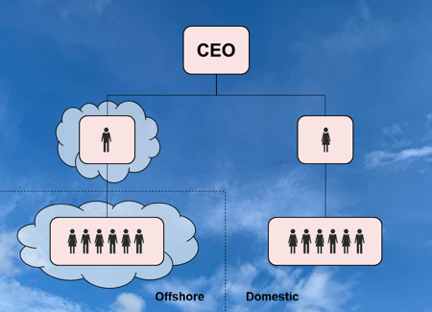- Why offshoring?
- What will the future look like?
- How does offshoring impact current employees?
- How should companies mitigate potential cultural impact and media coverage?
- How can employees minimize the negative effects of offshoring on their own situation?
- How should companies approach offshoring?
Introduction
In the few short months of early 2020, COVID-19 has resulted in global workplace upheaval. Numerous jobs have been lost or furloughed, and a significant number of employees have been shifted to working from home. Today’s article deals with this latter group.
In the past, companies have typically required workers to show up at the office, for a variety of reasons. A non-exhaustive list includes:
- Not trusting workers to be productive from home
- Job requires access to certain equipment not available at home
- Company wanting to ensure that workers put in the contracted number of hours
- Company belief that cohesiveness is best served by interaction at the office
- Senior management belief that face to face interaction is more effective than remote
Yet over time, there has been a slow shift toward increased remote working. Some jobs have, for a long time, already required extensive travel — for example, salespeople, regional corporate roles, and management consultants. Others are equally (or perhaps more) effectively performed from home or a remote location, like customer service via phone, software development, and content writing. It is clear that, for some roles at least, remote work ranges from “necessary” to “optional but equally effective versus office work”.
With COVID-19 having forced many companies into at least a partial work-from-home mode, these organizations have worked out methods to continue doing business to a workable level of effectiveness and efficiency. They may have discovered that some roles and staff are better suited to working from home, and may have considered a permanent shift for these roles. There are some obvious benefits including reduced office costs e.g. rental, utilities, equipment like desks and chairs, consumables like tissue paper and coffee; elimination of commuting time and cost; and others. There are some less obvious benefits like saving on childcare and time spent with family. There are also some negatives, including stress (workers report that this comes with increased time spent with the children — however, this is partly due to homeschooling during COVID-19), reduced social interaction with colleagues, reduced sense of support from superiors, and others.
Why offshoring?
Offshoring means moving jobs out of the country, and comes in two flavors — offshoring to a foreign location of the company either pre-existing or new; and offshoring plus outsourcing to a foreign located 3rd party. In both cases the primary goal is to reduce cost, shifting labor from high-priced local labor to a country that can deliver the work at a lower cost and at an acceptable level of performance. The level of performance is judged by criteria which may include quality/accuracy, speed/timeliness, communication, and others. For the purposes of this article, we are primarily referring to offshore outsourcing, where not otherwise specified.
In a situation where companies have realized that at least some of the jobs that are being performed remotely under COVID-19 are highly suitable for remote work, they will observe potential for reduced cost. Taking rental as a prime example, each person may occupy a 2x3m cubicle at the office. Enough jobs moved to home means reducing office footprint and rent, as sections may be returned to the landlord, or the company could move to smaller premises.
But why stop there? If you have decided that people can work from home, do they even need to be in the same country as the office? Call centers and IT are typical departments that are often offshored to India, the Philippines, or other countries with appropriate capabilities. Labor costs can be reduced by 80–90% for many roles, e.g. data entry and customer support. However, after taking into account additional management costs, telecommunications and other costs of remote work, companies can achieve net cost savings in the 50% range. Offshoring also offers the opportunity to re-engineer business processes, which can add another 30–40% saving on the total offshore cost base (i.e. ~65%+ saving in total compared to the original home-country cost base).
Sometimes the performance or customer perception of these initiatives can be slightly negative, but a combination of increasing acceptance and familiarity with foreign service providers, and gradual performance improvement through training (e.g. accent and fluency training for call centers) usually yields acceptable results. These results plus the reduced costs can combine to be a long term preferred option. Reduced internal organizational complexity via outsourcing to a 3rd party is another potential benefit.
What will the future look like?

Let’s fast forward for a moment and visualize what the world will be like after post-COVID offshoring. In some organizations, offshoring has already moved manufacturing facilities; support functions like IT, accounting and finance; and even some strategic functions like R&D and new product development, to foreign locations. However, numerous roles previously thought of as best suited to working at head office or other domestic facilities have remained in-country.
Under COVID, senior management will likely observe that, when these roles are performed remotely, they can be categorized into low, medium and high effectiveness. Those with high effectiveness may even exceed their normal performance. These roles make the most sense to keep as remote roles, and are the prime target for offshoring consideration. The medium-effectiveness roles, with some adjustment, will be a secondary target. Low-remote-effectiveness roles will be the ‘core’ that is best suited to work at the domestic facilities.
If high and medium effectiveness roles are shifted to home or offshore, company facilities will be significantly smaller. This will vary by company, but only 3.4% of workers currently work remotely (USA data). However, this figure is increasing at a fairly fast pace. Also, note that some jobs could be partially performed remotely, e.g. 3 days from home, 2 days at the office; or 60% performed by an offshore 3rd party, and 40% performed by a critical ‘core’ worker in the office. Technology including faster internet, webcams, video conference services, shared online workspaces, instant messaging, and others have made it a lot easier to be effective remotely. 3.4% of roles being remote today leaves much room for change.
Envisaging a shift of 30–50% of on-premises roles in big corporations to home or offshore locations means a major downsizing of facility sizes and physical workplace interaction. Bosses will have to become more effective at managing physically dispersed employees and service providers, potentially in various time zones. Employees will have to be disciplined and conscientious or else perform sub-optimally. They will also have to be more comfortable with reduced face to face supervision and guidance, but this can be substituted by online communication. Everyone, whether at home, offshore, or in domestic offices, will be dealing with a mix of locations, cultures and roles that may be substantially more diverse than in the past.

In terms of locations for offshored activity, India has been a strong player in recent decades. However, Latin America and Europe can expect to capture significant growth going forward. There is an increasing focus on process and people as opposed to simply seeking the best price. If offshored service providers can deliver ease of process and talented workers, they will attract customers that are willing to pay more for a premium, high quality service.
How does offshoring impact current employees?
There will likely be substantial negative impact on the current workforce, and this is critical for companies to understand and manage in the process of offshoring. Existing local employees will likely feel upset, stressed, and anxious, as they will feel they are being replaced. They will fear financial issues they may face in the future, and the uncertainty can be more stressful than clearly knowing they will lose their job. It may also confuse those who don’t understand why the organisation is outsourcing particular tasks and jobs. In addition, offshoring will certainly change, and likely add challenges to, the daily workflow of employees that remain post-offshoring. The impacts on individual employees can sum to a sizable negative effect on company culture.
How should companies mitigate potential cultural impact and media coverage?
It is vital that company leadership protect the organization against cultural impacts by discussing their decisions with team members who could be impacted. Leaders must be mindful that the loss of employment is being imposed on team members, who have little or no choice in the matter.
Planning the sequence and content of communication is critical. During the initial phases, often the offshoring project is kept secret, to avoid alarming the workforce unnecessarily. Confidentiality must be maintained by the internal project team and external consultants who may be involved. After all, it is possible that the diagnostic will conclude that offshoring is not viable or appropriate. However, once it becomes clear that the company intends to go through with offshoring, it must decide when to reveal this information to the affected portions of the workforce. The timing, method and content of this process must be clearly set out in the communication plan, and implemented correctly.
Techniques used to achieve desired outcomes include:
- Offers of outplacement services and counseling for impacted employees — these can reduce the challenges displaced workers face
- Above-contract/regulation termination packages
- Voluntary redundancy which enables employees to have some self-selection, since those who want to leave will opt in
- Inclusion of key team leaders in the project from inception — this assists in achieving buy-in and understanding of the need for the project
Further, management must proactively shape positive media coverage around the offshoring to ensure there is an accurate perception of the situation, being in the best interest of the organization and its team members. If the company has a high public profile and is a major employer in its local market, major objections can arise. Proactive engagement with media and other community stakeholders can pay dividends in defusing such objections.
How can employees minimize the negative effects of offshoring on their own situation?
Employees in the post-COVID-19 world should keep an eye out for the potential for offshoring in their organization. If there is a meaningful likelihood of their role being offshored, some ways to mitigate the effects include:
- Gaining broader knowledge of the organization to display own value
- Improve own job performance; make suggestions for positive change, including cost-cutting and innovative actions
- Be part of a team to expose own skills to other departments
- Upgrade own education/skill set to gain or enhance leadership skills
- Network with decision-makers
- Connect organizational resources and people with each other — focus on relationship skills and project management
- Bring in revenue by accessing new business opportunities — get close to the customers
- Exceed work expectations every day
The above ideas will hopefully make the employee more valuable to the organization and less likely to be rationalized as part of an offshoring effort. However, if it appears likely that one’s role will not be retained, it is time to research and access new employment opportunities inside and outside the organization, fine tune the resume, and seek interviews.

How should companies approach offshoring?
There are five main steps:
1.Diagnostic Assessment — determine whether a significant portion of roles are effective remotely. This is done by extracting key data from the personnel database, including division/department, position title, employee name (or Currently Vacant as appropriate), and total salary package. Roles are then grouped into high, medium and low remote effectiveness. This enables assessment of the total number of roles and total cost of the roles in each category. If a substantial portion of roles fall into “high” and “medium”, and particularly if they are concentrated in certain departments or business units, there is likely to be substantial outsourcing/offshoring opportunity.
2.Impact Analysis — for high and medium categories, estimate potential cost savings and other impacts from outsourcing/offshoring (“O&O”) options. These options include in-house offshoring, local outsourcing, and offshore outsourcing. The cost impacts must consider both one-off and on-going costs. One-off costs include retrenchment and the setup and transition costs of O&O. Ongoing costs impacts are primarily the differential between the annual cost of having the role performed under the status quo and under the newly considered options, and any overall management fees an outsourced services provided may charge. Non-financial issues and impacts should also be assessed, e.g. morale, effectiveness reduction, strategic importance of roles — and where appropriate, an estimate of their financial impact can also be developed.
3.Decision Making — decide whether the targeted benefits are sufficient to engage in an O&O program. Clearly define the scope, goals and high level timeline of the O&O program. Select areas and roles to undergo O&O, what type of O&O to implement (from the options mentioned above), and prioritize the major components of the program.
4.O&O Planning
- High Level Roadmap — develop overall roadmap and initiatives, with priority initiatives in particular being allocated earlier timeframes, adequate budget, and high quality resources to manage these initiatives.
- Implementation Planning — detailed steps for each initiative so that costs are effectively controlled, output quality is ensured, and targeted time to completion is achieved.
5. Implementation — this component itself comprises multiple steps, to be applied for each impacted area of the company.
- Assign roles and launch initiatives.
- Assess and confirm O&O option. Considerations include: offshoring includes deciding whether to use existing facilities or build new owned facilities, or outsource to 3rd party.
- If outsourcing, identify the shortlist of service provider options, profile them, select those who you want to bid, prepare bid documents/RFP, receive proposals, assess proposals, determine the winning bidder, and finalize contracts.
- Define the exact processes — process maps and procedures; KPIs; inputs/outputs/data items; data security requirements; service level agreements; control, monitoring and evaluation; knowledge transfer, etc.
- Implement transfer of work processes and knowledge, using the implementation plan and the process definitions.
- Commence live operation. There will likely be a short period during which the original resources will remain in place to assist with any issues, until the operation is running smoothly.
Contact Us
O&O ranges in scale from small to very large, and the potential benefits are commensurate. The larger the project is, the more challenging it is to achieve success. Some companies will have already gone through these processes and have the capability to implement them without assistance. Others will have strategic project teams, essentially internal management consultants, that can take on these projects. For companies that lack the resources to assess and implement offshoring, assistance is available from consulting firms which have assisted clients with successfully completing such projects.
If your organization is considering outsourcing and offshoring and may need assistance, please contact us at OML for a complimentary 30 minute discussion. We would be pleased to help talk through your company’s needs and how to address them. Our offering spans diagnostics, planning and implementation to counseling, coaching and advisory for management and affected employees — all of which can help you deliver maximum value with your O&O efforts and avoid pitfalls. Please email [email protected] to connect with us.
About the author

Originally from Australia and now based in Thailand, Paul E. Tan has 20 years professional experience, of which 15 have been in management consulting. Previously employed by The Boston Consulting Group and A.T. Kearney, he assisted in founding OML Consulting with partners in Asia and Europe. His work has focused on business strategy and organizational transformation in Asia and Australia.
